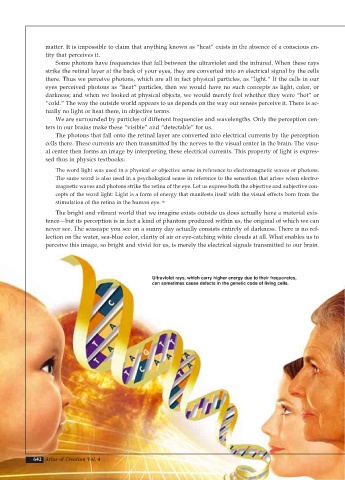Page 644 - Atlas of Creation Volume 4
P. 644
matter. It is impossible to claim that anything known as “heat” exists in the absence of a conscious en-
tity that perceives it.
Some photons have frequencies that fall between the ultraviolet and the infrared. When these rays
strike the retinal layer at the back of your eyes, they are converted into an electrical signal by the cells
there. Thus we perceive photons, which are all in fact physical particles, as “light.” If the cells in our
eyes perceived photons as “heat” particles, then we would have no such concepts as light, color, or
darkness; and when we looked at physical objects, we would merely feel whether they were “hot” or
“cold.” The way the outside world appears to us depends on the way our senses perceive it. There is ac-
tually no light or heat there, in objective terms.
We are surrounded by particles of different frequencies and wavelengths. Only the perception cen-
ters in our brains make these “visible” and “detectable” for us.
The photons that fall onto the retinal layer are converted into electrical currents by the perception
cells there. These currents are then transmitted by the nerves to the visual center in the brain. The visu-
al center then forms an image by interpreting these electrical currents. This property of light is expres-
sed thus in physics textbooks:
The word light was used in a physical or objective sense in reference to electromagnetic waves or photons.
The same word is also used in a psychological sense in reference to the sensation that arises when electro-
magnetic waves and photons strike the retina of the eye. Let us express both the objective and subjective con-
cepts of the word light: Light is a form of energy that manifests itself with the visual effects born from the
stimulation of the retina in the human eye. 35
The bright and vibrant world that we imagine exists outside us does actually have a material exis-
tence—but its perception is in fact a kind of phantom produced within us, the original of which we can
never see. The seascape you see on a sunny day actually consists entirely of darkness. There is no ref-
lection on the water, sea-blue color, clarity of air or eye-catching white clouds at all. What enables us to
perceive this image, so bright and vivid for us, is merely the electrical signals transmitted to our brain.
Ultraviolet rays, which carry higher energy due to their frequencies,
can sometimes cause defects in the genetic code of living cells.
642 Atlas of Creation Vol. 4

